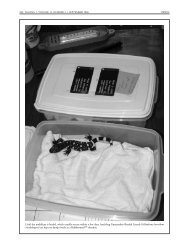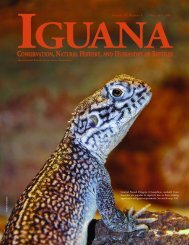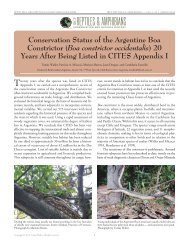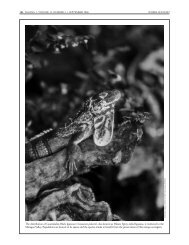Spiny-tailed Iguanas (Ctenosaura similis) in Venezuela
Spiny-tailed Iguanas (Ctenosaura similis) in Venezuela
Spiny-tailed Iguanas (Ctenosaura similis) in Venezuela
You also want an ePaper? Increase the reach of your titles
YUMPU automatically turns print PDFs into web optimized ePapers that Google loves.
ROBERT POWELL<br />
ROBERT POWELL JEFFREY W. ACKLEY<br />
AMPHIBIANS AND REPTILES OF DOMINICA<br />
W<strong>in</strong>dward Dwarf Geckos (Sphaerodactylus v<strong>in</strong>centi monilifer) occur <strong>in</strong><br />
leaf litter of upland ra<strong>in</strong> forests and habitats modified for agriculture<br />
to elevations as high as 900 m. These geckos are much less frequently<br />
encountered on Dom<strong>in</strong>ica than S. fantasticus. Sphaerodactylus v<strong>in</strong>centi<br />
is sexually dimorphic. Males have two black “eye-spots” (ocelli) on the<br />
shoulders, whereas females lack ocelli, but have light spots on the<br />
shoulders.<br />
Throughout much of the species’ range, Turnip-<strong>tailed</strong> Geckos<br />
(Thecadactylus rapicauda) are less likely to associate with humans than<br />
“house” geckos <strong>in</strong> the genus Hemidactylus. On Dom<strong>in</strong>ica, however,<br />
these large geckos frequently exploit <strong>in</strong>sects attracted to lights at night<br />
and take advantage of the many cracks and crevices <strong>in</strong> build<strong>in</strong>gs to seek<br />
refuge by day.<br />
IGUANA • VOLUME 15, NUMBER 3 • SEPTEMBER 2008 139<br />
nann, Mabouya Hòtè. English common names: Thick-<strong>tailed</strong><br />
Gecko, Turnip-<strong>tailed</strong> Gecko. Neotropical endemic; presumably<br />
native on Dom<strong>in</strong>ica. These geckos (male SVL to 125 mm,<br />
female SVL to 126 mm) occur <strong>in</strong> dry forests and are arboreal.<br />
They often exploit the night-light niche and can be common <strong>in</strong><br />
artificial habitats, although they are less likely to function as<br />
human commensals than Hemidactylus mabouia. They are<br />
known to be nocturnal but have been found bask<strong>in</strong>g dur<strong>in</strong>g the<br />
day. Ground color and pattern elements are highly variable,<br />
rang<strong>in</strong>g from unicolored pale to dark gray, brown, or even deep<br />
orange to hav<strong>in</strong>g variable dark brown to slate gray or black<br />
mark<strong>in</strong>gs. Color can change dramatically from day to night.<br />
Like many geckos, T. rapicauda is vocal, often produc<strong>in</strong>g a series<br />
of chirps decreas<strong>in</strong>g sequentially <strong>in</strong> volume. The diet consists of<br />
<strong>in</strong>sects, other small arthropods, and occasionally smaller lizards.<br />
The disproportionately swollen tail, especially when regenerated,<br />
is used to store fat. The conservation status of these widely distributed<br />
geckos has not been assessed.<br />
Snakes (Reptilia: Squamata)<br />
Boa nebulosa (Lazell 1964). Squamata: Boidae. Local names:<br />
Tête-chien, Tèt-chyen. English common name: Clouded Boa.<br />
Dom<strong>in</strong>ican endemic. These large nocturnal snakes (maximum<br />
SVL ~3 m) occur <strong>in</strong> woodland and montane forests, scrub, and<br />
Clouded Boas (Boa nebulosa) are the largest snakes on Dom<strong>in</strong>ica.<br />
Until recently, they were considered a subspecies of the wide-rang<strong>in</strong>g<br />
B. constrictor.<br />
on vegetated cliff faces. They can sometimes be found <strong>in</strong> more<br />
disturbed areas, such as along the edges of banana fields. They<br />
seek shelter by day <strong>in</strong> hollow logs, rock piles, tree roots, and<br />
under natural and human debris. Ground color ranges from tan<br />
PETER J. MUELLEMAN ROBERT POWELL








